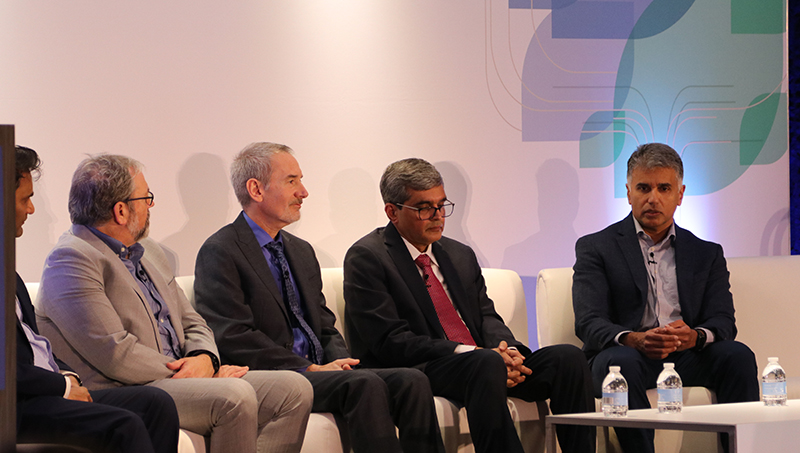Despite a pressing demand, schizophrenia has had limited treatment.
“Roughly 1% of the entire world population has schizophrenia,” said Boobalan Pachaiyappan, Managing Director and Senior Biotech Analyst at Roth Capital Partners, moderating a panel, Tackling Mental Health through New Targets and Endpoints Progress, during the 2025 Biotechnology Innovation Organization (BIO) CEO and Investor Conference.
“This translates to approximately 24 million people worldwide and roughly 3 million or so, just in the United States.”
Until recently, options for treatment were limited, and the options available were not necessarily ideal, as they came with side effects that often resulted in non-adherence and relapse, Pachaiyappan noted. However, with the Food and Drug Administration (FDA) approval of Cobenfy for schizophrenia on Sept. 26, the tide seems to be turning.
Why schizophrenia is difficult to treat
One of the main challenges in treating schizophrenia is that it manifests in three types of symptoms: “positive,” “negative,” and “cognitive.”
“The most obvious symptoms of schizophrenia are the psychotic symptoms: delusions, hallucinations, other disturbances of thought and understanding, as well as the inability to tell the difference between reality and these internal experiences,” explained Joshua Gordon, Professor and Chair of the Department of Psychiatry at Vagelos College of Physicians and Surgeons at Columbia University, and Executive Director of New York State Psychiatric Institute. “Those are what we call positive symptoms.”
These symptoms are, in effect, the most well-known symptoms of schizophrenia and the focus of anti-psychotic drugs. Historically, dopamine D2 receptor antagonist (D2) drugs have been the most widely used drugs to treat the disorder. Their development was based on the “dopamine hypothesis,” which stated that schizophrenia was caused by an overproduction and an over-release of dopamine in certain parts of the brain.
“There’s really only been a single class of medications to treat schizophrenia for about 70 years, and most of them had antagonistic, blocking activity at dopamine receptors, whether they be D2 or D3 receptors, with some other activities,” explained Ken Kramer, Vice President and Head of Medical Affairs, Neuropsychiatry Therapeutic Area at BMS.
The approximately 25 schizophrenia medications on the market all work in about the same way. The problem is that these drugs, while having a great deal of success treating positive symptoms, didn’t do much to treat “negative” symptoms and come with a variety of unpleasant side effects.
“The main challenge with antipsychotics is the failure to deliver improvements in cognition and negative symptoms,” said Dr. Gordon. “There are many other problems, some specific to some subsets of antipsychotics. These include motor side effects, weight gain, and metabolic disruption.” Additionally, as Dr. Gordon explained, there is also a larger, less understood issue: the greatly reduced lifespan for schizophrenia patients.
Furthermore, no two patients with schizophrenia are the same, so a more complex understanding of negative and cognitive symptoms from patient to patient is important. As research and understanding of schizophrenia evolved, so did the means of treating it.
What are ‘negative’ and ‘cognitive’ symptoms?
“The negative symptoms include social withdrawal—that can be independent from the paranoia that often accompanies delusions—decreased self-care, decreased exploration of the world, and really just a wholesale withdrawal from society,” explained Dr. Gordon.
These symptoms tend to be harder to spot. They also often show up earlier than positive symptoms—which can lead to an early misdiagnosis—and have historically been harder to treat, said Laxminarayan Bhat, CEO of Reviva Pharmaceuticals Inc.
But identifying negative symptoms and their progression is key, since mitigating and improving that progression often has the added benefit of mitigating and improving the deterioration of cognitive symptoms.
Cognitive symptoms include “a full range of disruptions in cognition, although with a particular focus on areas of higher cognition, which are typically carried out by your prefrontal cortex. This includes working memory, planning, evaluating future rewards and expectations, etc.,” Dr. Gordon said.
Reviva is currently developing a D2 drug and mapping its efficacy against the manifestation of negative symptoms by incorporating biomarkers to map progression.
“In our study, we use vocal biomarkers to evaluate negative symptoms,” he explained. “Schizophrenia patients in general, especially negative-symptom patients, have speech patterns that are very signature in the sense that there is a lagging kind of speech we call speech latency. A normal person or physician may talk to interactive patients but may not be able to evaluate them accurately to a certain extent. But machine learning and AI can, to a great extent, even in just seconds, differentiate a lagging speech pattern from a normal one.”
The impact of Cobenfy on the market
The approval of Cobenfy marked a paradigm shift in treating schizophrenia, said the panelists.
First, tolerability issues with D2 drugs contributed a great deal to the poor adherence to treatments, with 77% of patients quitting treatment within 12 to 18 months and then moving to a different option and picking it up, often with equally poor results.
By selectively targeting M1 and M4 receptors in the brain without blocking D2 receptors, Cobenfy addresses many of the cognitive and negative symptom issues as well as tolerability issues.
When describing how Cobenfy works, Kramer used the teeter-totter example he learned in school.
“I remember back in one of my first neurobiology lectures, seeing the professor put a teeter-totter up and say these are very inversely related,” he explained. “If dopamine is high, acetylcholine goes low; acetylcholine goes high, dopamine goes low. The idea was that we’ve always been treating schizophrenia as too much dopamine, and so we’ve been trying to improve the symptoms of it by pressing downward on it, by blocking those receptors. But there’s another way to do it. You can lift the other side. You can raise the activity of acetylcholine receptors, and that’s what xanomeline does. Cobenfy is a combination of xanomeline, which is an M1, M4 muscarinic receptor agonist, and trospium, which helps with tolerability.”
These developments harken what drug developers hope will be a new age of treating extreme psychiatric disorders like schizophrenia.




